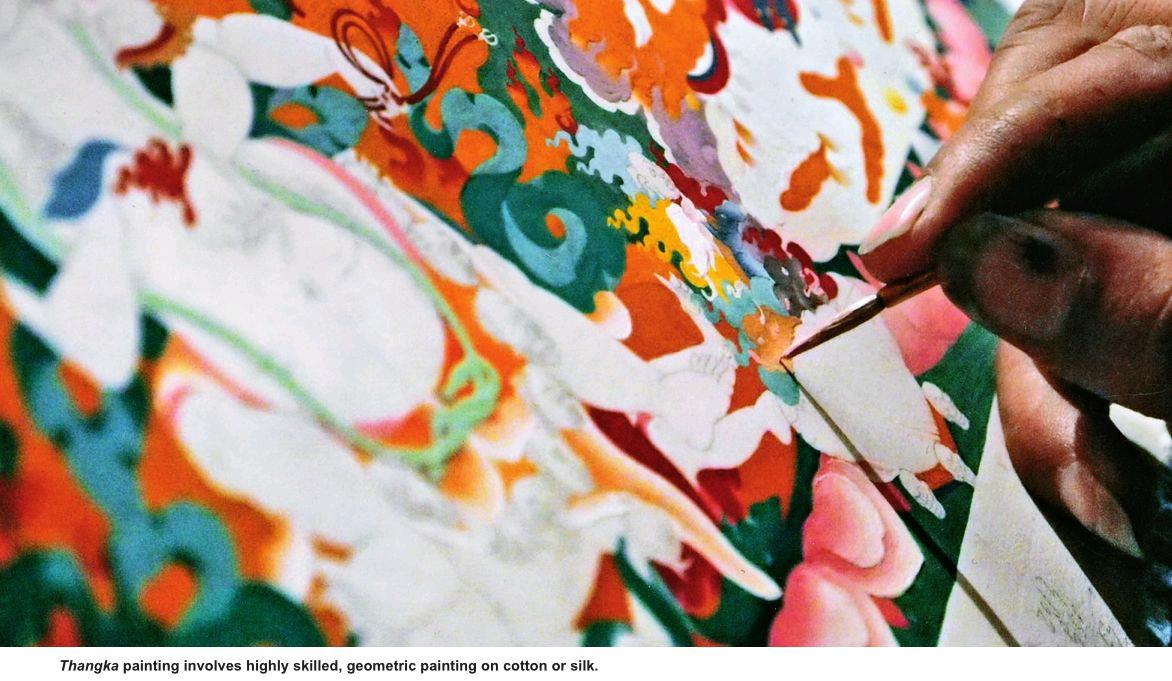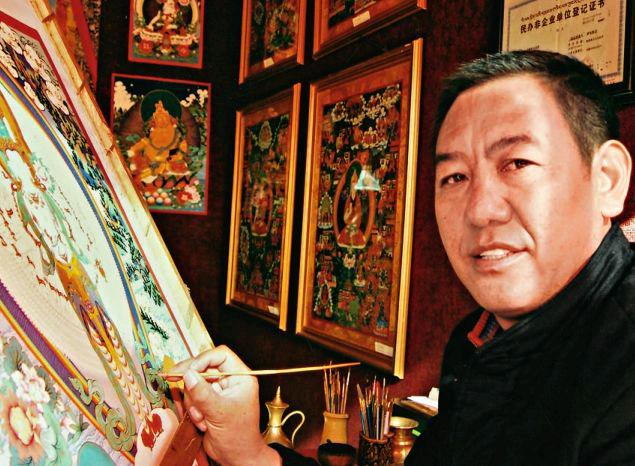Manzhong Norbusitar:The Lure of the Thangka
By+SO+CHUNG
FORTY-six-year-old Manzhong Norbusitar is a national inheritor of the intangible cultural heritage of Thangka painting, a traditional Tibetan art form. The fourth generation in a line of Tibetan artists, he showed a strong interest in Thangka from a young age. Thangka painting involves highly skilled, geometric painting on cotton or silk and usually depicts a Buddhist deity, a ritual scene or symbol. Norbusitar learned the necessary techniques from his grandfather, famous Thangka painter Dhawa Dhondrup, and was later apprenticed to renowned masters Karchen Lozang Phuntsog and Wuchen Ngadun to learn more about Thangka art and related Buddhist knowledge.
Norbusitar uses his brush to record and disseminate traditional Tibetan culture. In doing so, he is making ceaseless efforts to cultivate a fifth generation of Thangka painters and encourage more students to study the art form.
Childhood Affinity with Thangka
The Chalalubu Monastery is on the hillside to the west of the Potala Palace square. Norbusitars studio, the Mensar School Thangka Art Development Center, is at the foot of the hill. Norbusitar is no great talker, but is very happy to tell others about his Thangka and paintings.
Norbusitar was born in 1967 in Xigaze, Tibet.“Five generations of my family have been dedicated to painting Thangka of the Mensar School.”At 12 years old, he started learning to paint from his grandfather Dhawa Dhondrup and continued under his tutelage until he was 19.
In 1987, the Tashilhunpo Monastery built a shrine to house the remains of the Fifth to Ninth incarnations of Panchen Lamas. Following his grandfather, Norbusitar participated in painting the murals adorning the tomb. It was at that time that he was discovered by Karchen Lozang Phuntsog, staff painter for the Tenth Panchen Lama, who became his master. He then studied Tibetan Buddhism, especially the art and skills of painting the Sakyamuni Buddha and various Buddha statues of the Vajrayana Sect. During these years, Norbusitar studied sutras, the proportion of statues and scale, and reproduced paintings of various clothing and statues. He also learned how to make and effectively use different tools, like canvas, brush pens and colors. Norbusitar also painted murals for many monasteries in Xigaze, including the Sakya Monastery and Tashi Gephel Monastery.
After years of apprenticeship and practice, Norbusitar gradually obtained a better understanding of the painting theories and skills of the Mensar School. His works were highly praised and many monasteries invited him to paint Thangka and restore damaged murals.
Since 2005, Norbusitar has independently taken on the task of restoring and reproducing the murals in the Mandala Hall of the Potala Palace. He replicated damaged murals in Thangka paintings of reduced proportions, so as to preserve the precious artwork.
“Copying is not simply imitation,” Norbusitar said. “It is a science, a kind of understanding, and an innovation.” Some parts of the murals he replicated were very badly damaged. Certain aspects were hard to distinguish, and the original paintings on which they were based couldnt be found anywhere in Tibet. It made the work very arduous. But Norbusitar thought that if it meant cultural heritage could be preserved and passed on to future generations, it was a worthy challenge.
To protect the relics, Norbusitar had to work in dim light with a brush pen in one hand and a magnifying glass in the other. He first had to paint the murals onto a white cloth, and then restore the damaged or missing pieces of the mural one at a time.
Some people viewed Norbusitars task as a pointless exercise that could hinder his capacity for artistic innovation. But Norbusitar realized that the prime task of protecting intangible cultural heritage is to pass on the traditional techniques and skills; only by mastering traditional skills yourself can you make a natural breakthrough and improve.
Handcrafted Charm
After centuries of development, several schools of Thangka painting evolved. Norbusitar is an inheritor of the Mensar School.
Founded by Tsangpa Choying Gyasto in the 17th century, the school is known for its characteristic rough lines, defined faces, strong colors, tall figures and fine art skills. The process of Thangka painting is unimaginably difficult. The basic procedures range from preparing the canvas, drawing lines, coloring and dyeing, to delineating with pigments, tracing designs and painting in gold, polishing colors and the intricate painting of Buddhas eyes –all by hand.
Choosing the right pigments is very important, as the abundance of pots found in Norbusitars studio showed all too clearly. “The pigments directly influence the colors of the Thangka,” Norbusitar explained. “All the pigments are made from natural minerals found in Tibet. They give the Thangka its bright colors. As the plateau is arid, the color remains as bright as if it were newly painted even after several hundreds of years. Modern chemical pigments cant achieve that.”
In addition, tools like glue, charcoal, Tibetan brush pens and boards are handmade by Norbusitar himself and his students. The skills involved in doing so are not found in many other places. After a set of complicated procedures, a Mensar School Thangka will have a genuine “style,” which is so beautiful that it cannot be described, only felt, Norbusitar said.
Important Mission
The remaining Thangka passed down from generation to generation are all classical; the current skills Norbusitar and his students use are largely the same as those used hundreds of years ago. “For a good painter, passing down as many skills as accurately as possible is an important mission.”
In 2010, the Mensar School Thangka Art Development Center was selected as Tibet Autonomous Regions Intangible Cultural Heritage Project. The center aims to preserve the heritage of Tibetan art and promote the traditional painting skills and theories behind the Thangka. It has taught over 90 poor students for free. The fifth generation of the Mensar School also studies here.
Over the last several years, Norbusitar has attended many exhibitions, both at home and abroad, to showcase traditional Tibetan paintings and their values. The reception has been overwhelming and made him very proud. He hopes to continue to propagate the Mensar School techniques and make Tibetan art accessible to more people. His aim is to expand the development center and recruit more students.

